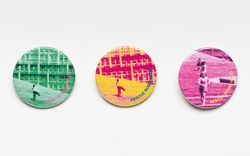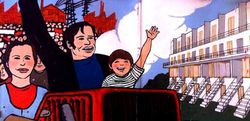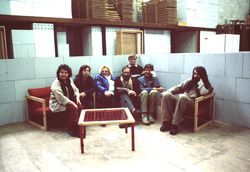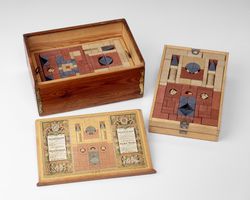Projet
AP164.S1.2003.D5
Description:
The project series documents the competition entry a plan of the Sagüés promenade, located at gates of Ulía park in San Sebastián, Spain. Abalos & Herreros and Renata Sentkiewicz drafted a study and proposal for the plan of the Sagüés promenade, located at gates of Ulía park in San Sebastián, Spain. The firm identified the project as number 165. The architects described their project as “[…] a place where […] [the urban and the natural] landscapes […] meet. Under a green roof a winter beach, thermal installations and the groundfloor [sic] of a hotel are combined. Five towers rise through this roof with different uses: hotel, social housing, and the ‘Gallery of Wonders’ […]. A passageway curls up around them, connecting the towers by an impactant [sic] skywalk […]” (ARCH270975). Documenting the project are conceptual, presentation and design development drawings, correspondence, project descriptions, notes, reports, resumes, and reference, photographic and digital materials.
circa 2001-2005
Sagüés, San Sebastián, Spain (2003)
Actions:
AP164.S1.2003.D5
Description:
The project series documents the competition entry a plan of the Sagüés promenade, located at gates of Ulía park in San Sebastián, Spain. Abalos & Herreros and Renata Sentkiewicz drafted a study and proposal for the plan of the Sagüés promenade, located at gates of Ulía park in San Sebastián, Spain. The firm identified the project as number 165. The architects described their project as “[…] a place where […] [the urban and the natural] landscapes […] meet. Under a green roof a winter beach, thermal installations and the groundfloor [sic] of a hotel are combined. Five towers rise through this roof with different uses: hotel, social housing, and the ‘Gallery of Wonders’ […]. A passageway curls up around them, connecting the towers by an impactant [sic] skywalk […]” (ARCH270975). Documenting the project are conceptual, presentation and design development drawings, correspondence, project descriptions, notes, reports, resumes, and reference, photographic and digital materials.
Project
circa 2001-2005
articles
Sauver le Robin Hood
Robin Hood Gardens, Londres, Smithson, habitation, logements sociaux, démolition, embourgeoisement
2 juin 2025
Sauver le Robin Hood
Lisa Belabed à propos d’un effort pour contrer la démolition dans le contexte d’une ville mondialisée
Actions:
archives
Niveau de description archivistique:
Fonds
Fonds Maxwell Levinson
AP037
Résumé:
The Maxwell Levison fonds (Shelter, T. Square) illustrates primarily the activities of Maxwell Levinson as editor of T-Square Club Journal, T-Square, Shelter and USA Tomorrow. It documents the various aspects of the publication of these magazines. It includes editorial, production and promotional material as well as documentation and research files. The fonds also contains records pertaining to the professional practice of Maxwell Levinson as architect and city planning consultant.
1926-1990
Fonds Maxwell Levinson
Actions:
AP037
Résumé:
The Maxwell Levison fonds (Shelter, T. Square) illustrates primarily the activities of Maxwell Levinson as editor of T-Square Club Journal, T-Square, Shelter and USA Tomorrow. It documents the various aspects of the publication of these magazines. It includes editorial, production and promotional material as well as documentation and research files. The fonds also contains records pertaining to the professional practice of Maxwell Levinson as architect and city planning consultant.
archives
Niveau de description archivistique:
Fonds
1926-1990
Projet
AP142.S1.D14
Description:
File documents an unsuccessful competition entry organized by the Istituto per lo sviluppo dell'edilizia sociale (ISES) for a housing project in Naples, Italy. Material in this file was produced in approximately 1965. File contains presentation drawings.
[ca. 1965]
Quartiere residenziale a Napoli
Actions:
AP142.S1.D14
Description:
File documents an unsuccessful competition entry organized by the Istituto per lo sviluppo dell'edilizia sociale (ISES) for a housing project in Naples, Italy. Material in this file was produced in approximately 1965. File contains presentation drawings.
File 14
[ca. 1965]
archives
Niveau de description archivistique:
Fonds
AP075
Résumé:
The Cornelia Hahn Oberlander fonds documents Oberlander's professional activities as a landscape architect. It contains over 203 projects that span from 1950 to 2018 predominantly in Canada and in the United States, but also in Germany. The fonds is a complete record of Oberlander's work, and comprises her playground projects, roof gardens, and public space landscapes, as well as landscape designs for private residences, as well as administrative records from her practice, her professional engagements, and her research materials. The material in this fonds is dated from 1936 to 2021.
1936-2021
Fonds Cornelia Hahn Oberlander
Actions:
AP075
Résumé:
The Cornelia Hahn Oberlander fonds documents Oberlander's professional activities as a landscape architect. It contains over 203 projects that span from 1950 to 2018 predominantly in Canada and in the United States, but also in Germany. The fonds is a complete record of Oberlander's work, and comprises her playground projects, roof gardens, and public space landscapes, as well as landscape designs for private residences, as well as administrative records from her practice, her professional engagements, and her research materials. The material in this fonds is dated from 1936 to 2021.
archives
Niveau de description archivistique:
Fonds
1936-2021
Évoquant un défi célèbre lancé par Le Corbusier, « Architecture ou révolution », cette conversation établira la place du processus du SAAL au Portugal parmi les débats internationaux des années 1960 et 1970 sur le logement social et la responsabilité de l’architecte dans ce domaine. Nuno Portas, secrétaire d’État au Logement et à l’Urbanisme nommé après la révolution(...)
Théâtre Paul-Desmarais
14 mai 2015 , 18h
Architecture ou révolution ? Une conversation avec Nuno Portas et Nuno Grande
Actions:
Description:
Évoquant un défi célèbre lancé par Le Corbusier, « Architecture ou révolution », cette conversation établira la place du processus du SAAL au Portugal parmi les débats internationaux des années 1960 et 1970 sur le logement social et la responsabilité de l’architecte dans ce domaine. Nuno Portas, secrétaire d’État au Logement et à l’Urbanisme nommé après la révolution(...)
Théâtre Paul-Desmarais
Après une intense période de travail au milieu des années 1970 consacrée au initiatives d’habitation lancées au Portugal après la révolution, Álvaro Siza participe dans les années 1980 à deux des plus importants programmes de renouveau urbain en Europe : l’Exposition internationale d’architecture (IBA) de Berlin et le Stadsvernieuwing als Kulturel Aktiviteit (le renouveau(...)
26 novembre 2015
L’archéologie de l’ordinaire d’Álvaro Siza
Actions:
Description:
Après une intense période de travail au milieu des années 1970 consacrée au initiatives d’habitation lancées au Portugal après la révolution, Álvaro Siza participe dans les années 1980 à deux des plus importants programmes de renouveau urbain en Europe : l’Exposition internationale d’architecture (IBA) de Berlin et le Stadsvernieuwing als Kulturel Aktiviteit (le renouveau(...)
Salle d’étude Mot(s)-clé(s):
chercheur en résidence 2018, Hans-Georg von Arburg, logement social, Allemagne, jouets
9 août 2018, 18h30
Salle d’étude Mot(s)-clé(s):
chercheur en résidence 2018, Hans-Georg von Arburg, logement social, Allemagne, jouets
archives
Niveau de description archivistique:
Fonds
Fonds Pierre Jeanneret
AP156
Résumé:
Le Fonds Pierre Jeanneret documente la pratique professionnelle et la vie personnelle de l'architect Pierre Jeanneret de ses études et ses projets professionels en Europe à ses projets architecturaux à Chandigarh, en Inde. Les documents du Fonds consistent en des photographies, des dessins et des documents textuels relatifs à plus de 100 projets, principalement son travail pour le projet de la nouvelle ville de Chandigarh, en Inde, en 1951 à 1965. *** The Pierre Jeanneret fonds documents the professional practice and the personal life of architect Pierre Jeanneret from student and professional work in Europe to architectural projects in Chandigarh, India. The documents in the fonds consist of photographs, drawings and textual records relating to over 100 projects, predominantly his work for the project of the new city of Chandigarh, in India, in 1951 to 1965.
1870s-2011
Fonds Pierre Jeanneret
Actions:
AP156
Résumé:
Le Fonds Pierre Jeanneret documente la pratique professionnelle et la vie personnelle de l'architect Pierre Jeanneret de ses études et ses projets professionels en Europe à ses projets architecturaux à Chandigarh, en Inde. Les documents du Fonds consistent en des photographies, des dessins et des documents textuels relatifs à plus de 100 projets, principalement son travail pour le projet de la nouvelle ville de Chandigarh, en Inde, en 1951 à 1965. *** The Pierre Jeanneret fonds documents the professional practice and the personal life of architect Pierre Jeanneret from student and professional work in Europe to architectural projects in Chandigarh, India. The documents in the fonds consist of photographs, drawings and textual records relating to over 100 projects, predominantly his work for the project of the new city of Chandigarh, in India, in 1951 to 1965.
archives
Niveau de description archivistique:
Fonds
1870s-2011
Projet
CD034.S1.1974.PR01
Description:
This project series contains four reproductions of drawings displayed in the exhibit to document the neighbourhood Quinta do Bacalhau-Monte Coxo, in Lisbon, Portugal. The exhibit text explained the following: The project architect Manuel Vicente was already working on a design for the intervention in the Quintas de Bacalhau and Monte Coxo when he was co-opted by SAAL. The proposed typology referred to another ambitious urban project of 615 housing units, Quinta das Fonsecas - Quinta da Calçada neighbourhood by the architect Raúl Hestnes Ferreira. The intention was to bring the city to the outlying shanty town areas. None of these projects was carried out in full, and they are now fragmented and besieged by the traffic system without having produced any of the essential community and socialising facilities. In Bacalhau-Monte Coxo the structure of the internal patios reveals the ways in which the public space and community was organised. The architecture assigned importance to the facades, although access to the community courtyards was also a central design concept. In a 1976 interview, the architect himself argued that the release of bourgeois guilt allowed for spatial beauty, adopting the slogan 'Facades First' in defence of architectural design. In a way, this proposal anticipated the post-modern, although in a form that did not deny architecture's social engagement. The design emphasizes a strong idea of architectural autonomy, unfortunately only a part of the project was actually built. (The SAAL Process, Housing in Portugal 1974–76) Manuel Vicente worked for SAAL/Lisbon and Central South with the following collaborators: Afonso José Baptista, Agostinho Xavier de Andrade, António Albano Leitão, Cristina Catela Martins Pereira, Eduardo Serrano de Sousa, Gentil Noras, José Manuel Diniz Cabral Caldeira, Manuel Augusto Lopes de Sousa, Nuno Matos Silva, Rita Cabral and the resident association Cooperativa de Habitação Económica Portugal Novo, that was founded on September 6th, 1974. The team built 384 dwellings. The operation began in September 1974, with a construction date in January 1977. This project series contains reproductions of design development drawings and a cadastral plan. The original drawings were produced in 1974 or after and were reproduced in 2015 for the exhibit.
circa 1974
Bairro Quinta do Bacalhau–Monte Coxo, Lisbon
Actions:
CD034.S1.1974.PR01
Description:
This project series contains four reproductions of drawings displayed in the exhibit to document the neighbourhood Quinta do Bacalhau-Monte Coxo, in Lisbon, Portugal. The exhibit text explained the following: The project architect Manuel Vicente was already working on a design for the intervention in the Quintas de Bacalhau and Monte Coxo when he was co-opted by SAAL. The proposed typology referred to another ambitious urban project of 615 housing units, Quinta das Fonsecas - Quinta da Calçada neighbourhood by the architect Raúl Hestnes Ferreira. The intention was to bring the city to the outlying shanty town areas. None of these projects was carried out in full, and they are now fragmented and besieged by the traffic system without having produced any of the essential community and socialising facilities. In Bacalhau-Monte Coxo the structure of the internal patios reveals the ways in which the public space and community was organised. The architecture assigned importance to the facades, although access to the community courtyards was also a central design concept. In a 1976 interview, the architect himself argued that the release of bourgeois guilt allowed for spatial beauty, adopting the slogan 'Facades First' in defence of architectural design. In a way, this proposal anticipated the post-modern, although in a form that did not deny architecture's social engagement. The design emphasizes a strong idea of architectural autonomy, unfortunately only a part of the project was actually built. (The SAAL Process, Housing in Portugal 1974–76) Manuel Vicente worked for SAAL/Lisbon and Central South with the following collaborators: Afonso José Baptista, Agostinho Xavier de Andrade, António Albano Leitão, Cristina Catela Martins Pereira, Eduardo Serrano de Sousa, Gentil Noras, José Manuel Diniz Cabral Caldeira, Manuel Augusto Lopes de Sousa, Nuno Matos Silva, Rita Cabral and the resident association Cooperativa de Habitação Económica Portugal Novo, that was founded on September 6th, 1974. The team built 384 dwellings. The operation began in September 1974, with a construction date in January 1977. This project series contains reproductions of design development drawings and a cadastral plan. The original drawings were produced in 1974 or after and were reproduced in 2015 for the exhibit.
Project
circa 1974



